Table of Contents
- Introduction
- What Are Iron Rods?
- What Iron Rods Are Actually Used in 2025 (And What’s Retired)
- TMT Grades Explained — Fe 500, Fe 500D, Fe 550, Fe 600
- Steel Price Trends in 2025 — What You’re Really Paying For
- Mistakes to Avoid When Buying Steel Rods
- 2025 Steel Trends to Watch (Future-Ready Sourcing)
- Conclusion
- FAQs
When it comes to construction, steel isn’t just another line item in the bill of quantity – it’s what holds the structure together, literally. And in 2025, choosing the right iron rods isn’t as straightforward as it used to be. Grades have changed, specifications have evolved, and pricing varies wildly across cities, brands, and bar diameters.
Whether you’re building a multi-storey commercial site or a small residential slab, getting the steel right can save you from costly rework and compliance headaches down the line. But with so many options – from Fe-500D to CRS bars, zinc-coated rods to prefabricated mesh – it’s easy to get lost in the jargon.
This guide breaks it all down: which bars are still being used, which ones are being phased out, how prices look in 2025, and what smart buyers are doing to avoid mistakes. If you’re sourcing steel this year, read this before you place the order.
What Are Iron Rods?
“Iron rods” is the everyday term most people use when they’re talking about reinforcement bars, or rebars – the steel bars that go inside concrete. These rods are what give strength and structure to beams, columns, slabs, and footings. Concrete handles compression well, but without reinforcement, it cracks under tension. That’s where iron rods come in.
Most rods used today aren’t pure iron – they’re made from steel, processed in different ways depending on the project. Some bend better, some resist corrosion, others carry more load. What you ask for at the supplier yard might be called “iron rod,” but what you’re really buying is a specific TMT bar, in a certain grade and diameter.
What iron rods are actually used in 2025 (And what’s retired)
Walk onto any live site in 2025, and you won’t hear much talk about HYSD bars or plain mild steel anymore. The steel game has changed – not just in what’s used, but in where and why.
TMT bars: Still the standard
TMT (Thermo-Mechanically Treated) bars are the workhorses of modern construction. They’re strong, they bend well, and they’ve proven reliable across everything from housing colonies to highway overpasses. Grades like Fe-500, Fe-500D, and Fe-550 are being used across the board – columns, slabs, beams, foundations. The ribbing helps grip concrete. The treatment keeps them steady under pressure, especially in high-heat zones or seismic-prone areas.
CRS bars: Gaining ground
If your project’s near the coast or in a flood-prone zone, CRS (Corrosion-Resistant Steel) bars are becoming the safer bet. They cost more, yes. But they last longer – especially in conditions where moisture, salt, or humidity can silently eat away regular TMT. You’ll see these more often in public works, marine zones, and water infrastructure.
Coated bars: Zinc & epoxy picks
Zinc-coated and epoxy-coated rods are seeing more orders, particularly for basement foundations, marine footings, or where soil is known to be salty or acidic. They’re harder to source locally, but many builders are insisting on them up front – knowing they won’t get a second shot once the concrete sets.
Welded mesh: Quietly rising
Slabs, compound walls, and industrial floors – that’s where welded mesh is showing up. Pre-sized and factory-set, it cuts down layout time and reduces errors. Doesn’t replace TMT for main loads, but it helps in fast-paced work.
What’s on its way out?
HYSD and mild steel bars aren’t really spec’d anymore. Mild steel’s too soft. HYSD doesn’t flex enough. If you’re being offered either for a structural job, it’s usually leftover stock or a poor substitution.
TMT Grades Explained – Fe‑500, Fe‑500D, Fe‑550, Fe‑600
Not all TMT bars are built the same. While the average buyer just asks for “TMT,” engineers and contractors choose by grade – because the grade decides how much load a bar can carry, how much it will bend, and how the building handles stress over time.
Here’s a practical breakdown of what each grade means on-site.
Fe‑500: The All-Rounder
Fe‑500 is the standard pick for most residential and mid-size commercial builds. Strong enough for slabs, beams, and columns – but still flexible enough to bend on-site without cracking. It’s what most structural drawings specify by default, unless there’s a special load or seismic requirement.
Fe‑500D: The Same, But More Ductile
That “D” stands for ductility. Fe‑500D has slightly lower carbon content in steel and higher elongation than regular Fe‑500. Translation? It stretches a little more before failing – which makes it better for earthquake-prone areas or buildings where shrinkage, vibration, or thermal expansion is a concern. Many structural consultants now recommend Fe‑500D even in non-seismic zones just for the added safety margin.
Fe‑550: For Heavier Loads
Fe‑550 is common in industrial builds – think warehouses, bridges, tall columns, long beams. It has higher tensile strength than Fe‑500, which means you can use slightly less steel for the same job. But it’s also a bit stiffer, which can make it harder to bend on-site. Good for pre-planned, engineered works – not ideal if the rebar detailing is still evolving.
Fe‑600: Still Rare, But Growing
Fe‑600 is used in high-load designs like infrastructure, metros, and precast work. Not many fabricators keep it in regular stock, but if your consultant calls for it, it’s probably for a reason. It’s overkill for regular housing – but a smart pick where load or span demands are extreme.
Steel price trends in 2025 – what you’re really paying for
Steel pricing in 2025 doesn’t follow one clean chart – it depends on where you are, what size you need, and which brand you trust. The numbers shift week to week, but here’s a ground-level view of what’s going on.
Brand-wise prices (November 2025)*
Premium brands still lead the pack. Here’s where they’re sitting now:
| Brand | Rate (₹/kg) |
| TATA Tiscon | ₹65–₹70 |
| JSW Neosteel | ₹69–₹72 |
| Kamdhenu | ₹62–₹65 |
| Meenakshi Steel | ₹61–₹62.5 |
| Generic Local Stock | ₹55–₹60 |
*These reflect widely reported TMT-bar market prices across major Indian cities for November 2025 – actual rate depends on grade (e.g., Fe 500D / Fe 550), rebar size, and local demand/supply dynamics.
If your supplier quotes higher, check the grade, batch, and whether price includes taxes/transport -these factors influence final landed cost.
By diameter: Price goes up as size goes down
In many parts of India, 8 mm–10 mm bars are priced slightly higher per kg compared to thicker bars. For instance, recent listings in Delhi show 8 mm bars at ~₹49.5/kg versus ~₹46.5/kg for 20 mm+. This reflects higher demand for thinner bars used in stirrups/secondary reinforcement. However, price depends heavily on brand, grade, and supply – so always confirm with your supplier
By region: Location still matters
Steel moves by truck – and logistics, demand & supply dynamics across cities continue to influence final landed cost. As of late 2025:
-
Mumbai/ Pune: ₹ 60–65/kg — higher logistics & port-driven costs, plus strong coastal demand & housing infrastructure.
-
Delhi NCR/ Chandigarh/ North-India belt: ₹ 62–66/kg — competitive dealer market keeps prices moderate; inland freight adds to landed cost.
-
Kolkata & East-India (WB, nearby cities): ₹ 58–63/kg — comparatively lower landed price due to local mills & lower freight overhead.
-
Bangalore/ Chennai/ South-India cities: ₹ 60–68/kg — demand-supply tightness for quality TMT bars and steel; premium grades push price up at times.
-
Tier-2/ Smaller Towns (where delivery lead-time, batch-size matter): ₹ 57–62/kg — depends on supply band, transport cost, and stock availability.
Note: These are indicative ranges for standard/Fe-500D / Fe-550 grade TMT bars and mild-steel long products. Price can shift by ±₹ 2–4/kg depending on brand, batch, availability, and delivery schedule.
When to buy: Timing still matters
Steel prices generally spikes between February and April, driven by project mobilisation, higher freight movement, fresh procurement cycles, etc. Rates tend to stabilise or soften during the monsoon months (July–September) when site activity slows and inventories build up.
From October to December, prices often stay steady – this period remains a good window for bulk ordering if demand is stable and mill output is consistent.
If your pour date is fixed, waiting rarely helps. During peak procurement months, prices can climb ₹2–₹4/kg within days, especially for branded TMT and MS long products.
Mistakes to avoid when buying steel rods
Steel isn’t where you want to cut corners — but it’s also where a lot of buyers do. And not just small-time contractors. Even large projects mess this up when they’re in a rush or chasing the lowest rate. Here’s what to watch out for.
Buying by price, Not grade
Just because two bars look the same doesn’t mean they are. A Fe-500D from a certified brand isn’t the same as a generic rebar with no batch markings. Cheap bars may not meet BIS specs, and if they fail after pouring — there’s no fixing that.
Ignoring site conditions
Building near the sea? In black cotton soil? In a flood zone? Then regular TMT isn’t enough. You’ll need CRS or coated bars. Too many projects skip this step and end up with corrosion before the paint even dries.
Trusting old specs
Some drawings still mention HYSD or mild steel. Doesn’t mean you should follow them blindly. Always check if the structural engineer has updated the BOQ. In 2025, most structural work expects Fe-500 or higher.
Not verifying ISI markings
ISI marking isn’t just a stamp — it tells you the bar meets minimum national standards. No ISI? Walk away. Some bars even have fake stamps, so check for batch numbers and heat codes.
Ordering too late
Prices fluctuate every few days. Wait till the last minute, and you’ll either overpay or miss your delivery window. For bulk orders, always plan 10–15 days ahead — especially if you’re sourcing a specific size or grade.
One wrong call in procurement can cost more than just a few rupees per kilo. It can cost the whole pour.
2025 steel trends to watch (Future-ready sourcing)
Steel procurement isn’t what it was five years ago. It’s no longer just about finding a decent bar at a decent rate. In 2025, the rules – and the expectations – have changed.
CRS and coated bars are becoming standard in tough zones
For years, corrosion-resistant and coated bars were considered optional — nice to have, not essential. That’s changed. Many public works departments now mandate CRS or epoxy-coated bars for any project near water, drainage, or in high-humidity regions. Private developers are catching on too. It’s not about price anymore — it’s about life cycle cost.
Fe‑550 and Fe‑600 are gaining market share
Fe‑500 is still the most used grade, but higher grades are starting to move. For bridges, tall structures, precast work, and longer spans, Fe‑550 and Fe‑600 are increasingly being recommended. Some suppliers now keep small quantities in stock — but lead times can still stretch.
Prefab mesh and precut steel are picking up
Speed is everything on big projects. Precut bars and welded mesh panels are showing up more often, especially on slab-heavy or repeat-build sites. They reduce on-site cutting, waste, and errors — but they need design coordination upfront.
Buyers are asking more questions
In the past, buyers focused on cost and delivery. Now they ask about BIS certification, batch codes, yield strength, even traceability. This shift is pushing dealers to clean up inventory and stock more certified material.
If you’re buying steel in 2025, don’t just think about today’s rate. Think about rework, compliance, and whether your decision holds up five years from now — when the structure is still standing, and you’ve moved on.
Conclusion
In construction, steel doesn’t get a second chance. Once it’s poured into concrete, it stays there — working quietly for decades. And that’s why getting your choice of iron rod right isn’t just a technical decision. It’s financial, structural and it’s long-term.
Whether you’re buying for a house, a warehouse, or a government contract, the landscape in 2025 demands more clarity than ever. Grades have changed, newer bar types are gaining ground, and pricing swings can catch even seasoned buyers off guard.
But if you understand what you’re buying — the grade, the coating, the relevance to your site — and if you source from certified, trusted suppliers, you’ll avoid the mistakes that lead to delays, disputes, or worse.
The bottom line? Don’t chase the cheapest bar. Chase the right one.
Looking to procure steel?
Tata nexarc helps manufacturers, builders and MSMEs source certified steel products, compare prices, and choose the right grade as per IS codes—with complete traceability and procurement confidence.
FAQs
What is iron rod used for?
- Construction of buildings, bridges, and roads for structural support.
- Reinforcement of concrete structures to improve strength and durability.
- Manufacturing industries for making machinery, tools, and equipment.
- Fencing, gates, and grills in residential and commercial properties.
What is the price of 1kg Loha?
Are iron rods and TMT bars the same?
TMT bars and iron rods are not exactly the same.
- Iron rods refer to general iron or steel rods used in various applications.
- TMT bars are a specific type of iron/steel rod that undergoes a thermo-mechanical treatment process, making them stronger, more ductile, and resistant to corrosion – ideal for modern construction projects.
Which iron rod is best for house?
How many rods are in 1 tonne of 12 mm iron rods?
How do I know if an iron rod is certified and safe to use?
What is the length of one iron rod?
How is the price of an iron rod calculated?
- Grade (e.g. Fe‑500, Fe‑500D, Fe‑550)
- Diameter (8mm, 10mm, 12mm etc.)
- Length (usually 12 meters)
- Weight (kg per piece varies with size)
How are iron rods manufactured today?
- Scrap metal or iron ore is melted in furnaces
- Molten metal is refined and cast into billets
- Billets are rolled into bars, quenched for surface strength
- Bars are tempered for ductility
- Final rods are cut to 12m lengths and batch-tested
Does Tata offer Fe 550 or Fe 600 TMT bars?
Sohini is a seasoned content writer with 12 years’ experience in developing marketing and business content across multiple formats. At Tata nexarc, she leverages her skills in crafting curated content on the Indian MSME sector, steel procurement, and logistics. In her personal time, she enjoys reading fiction and being up-to-date on trends in digital marketing and the Indian business ecosystem.
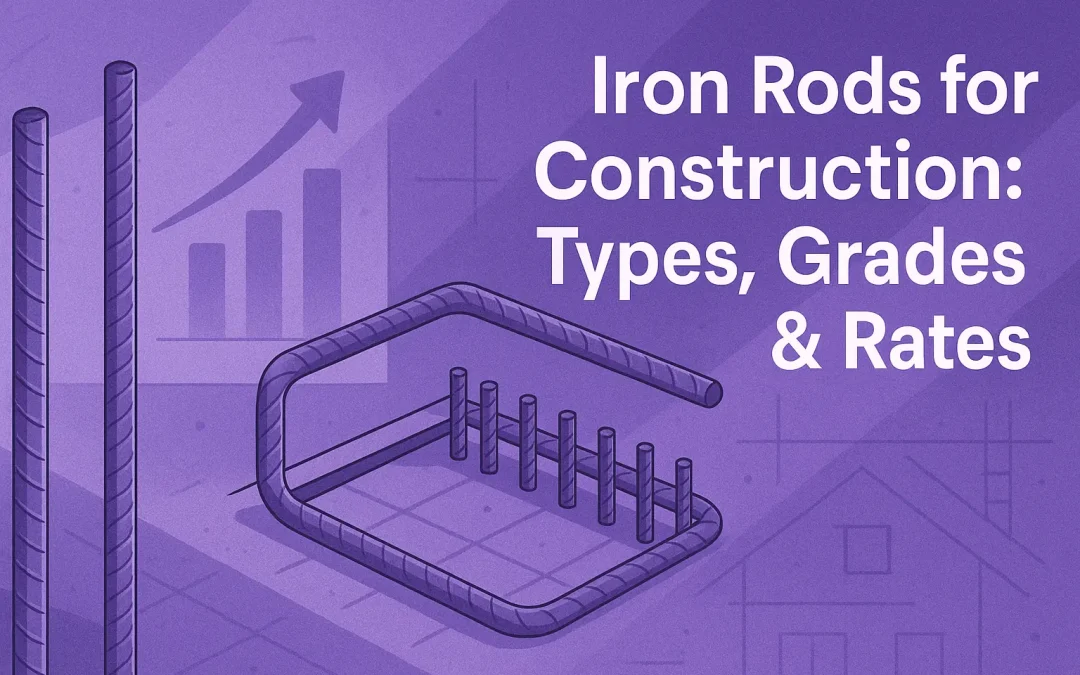
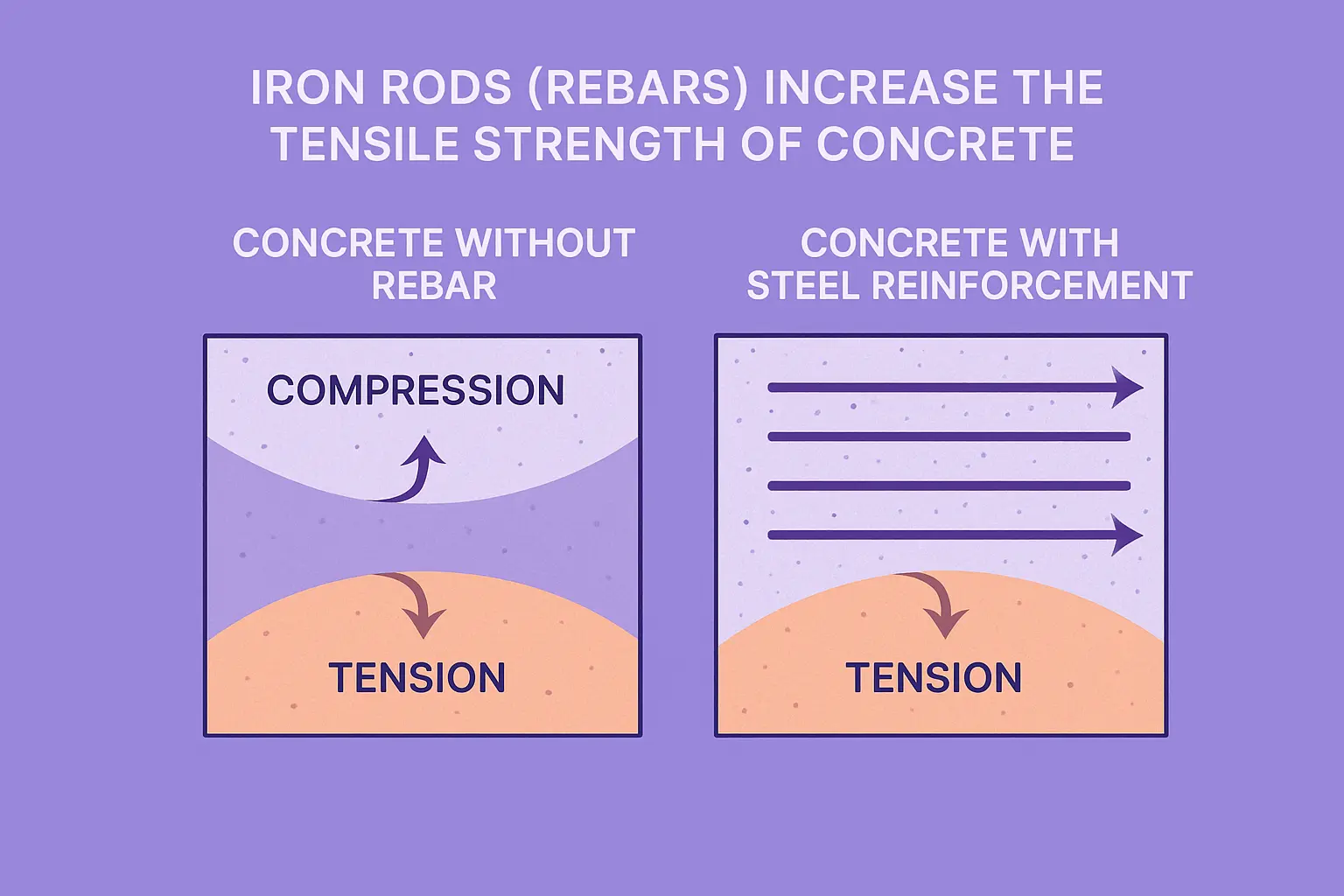
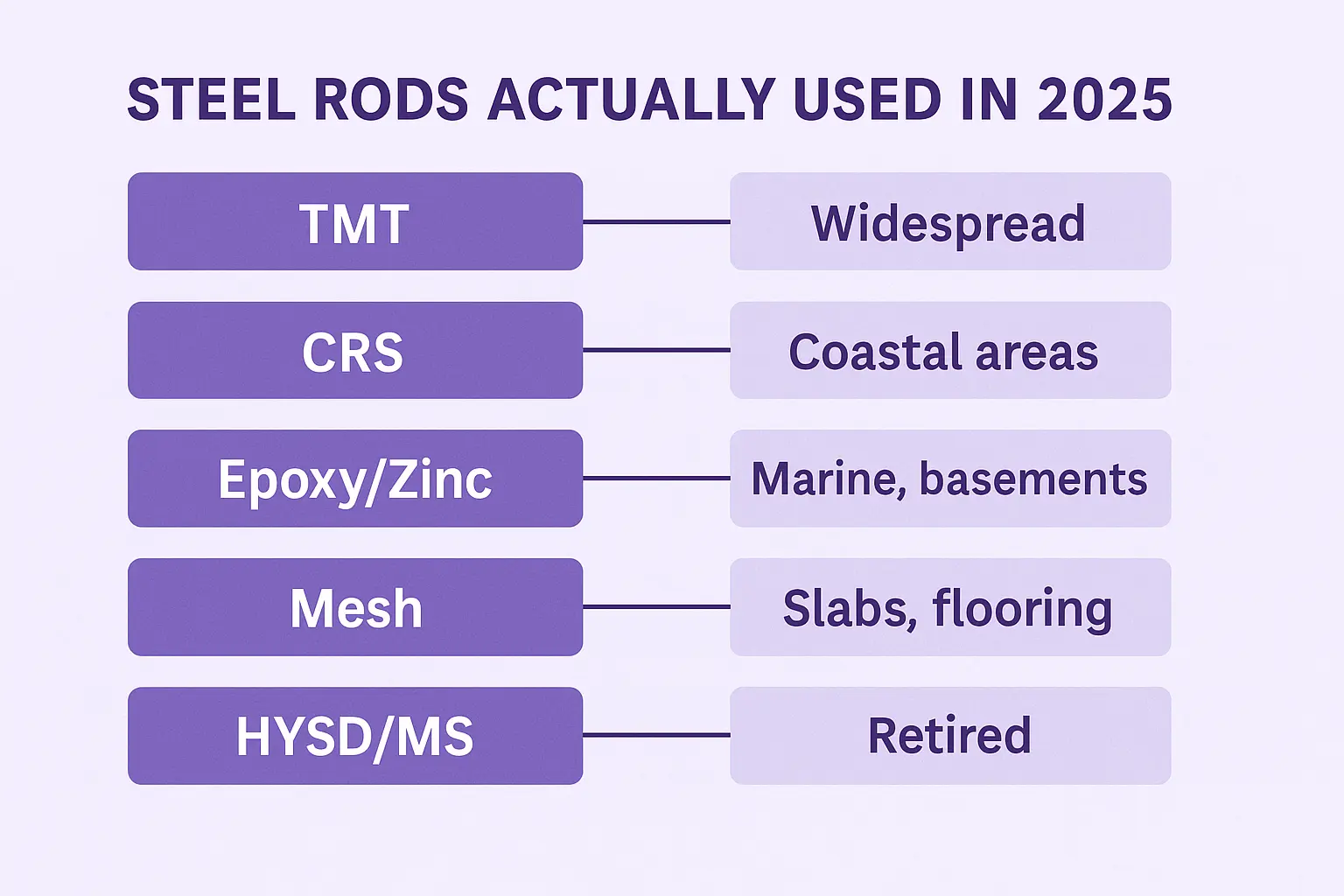
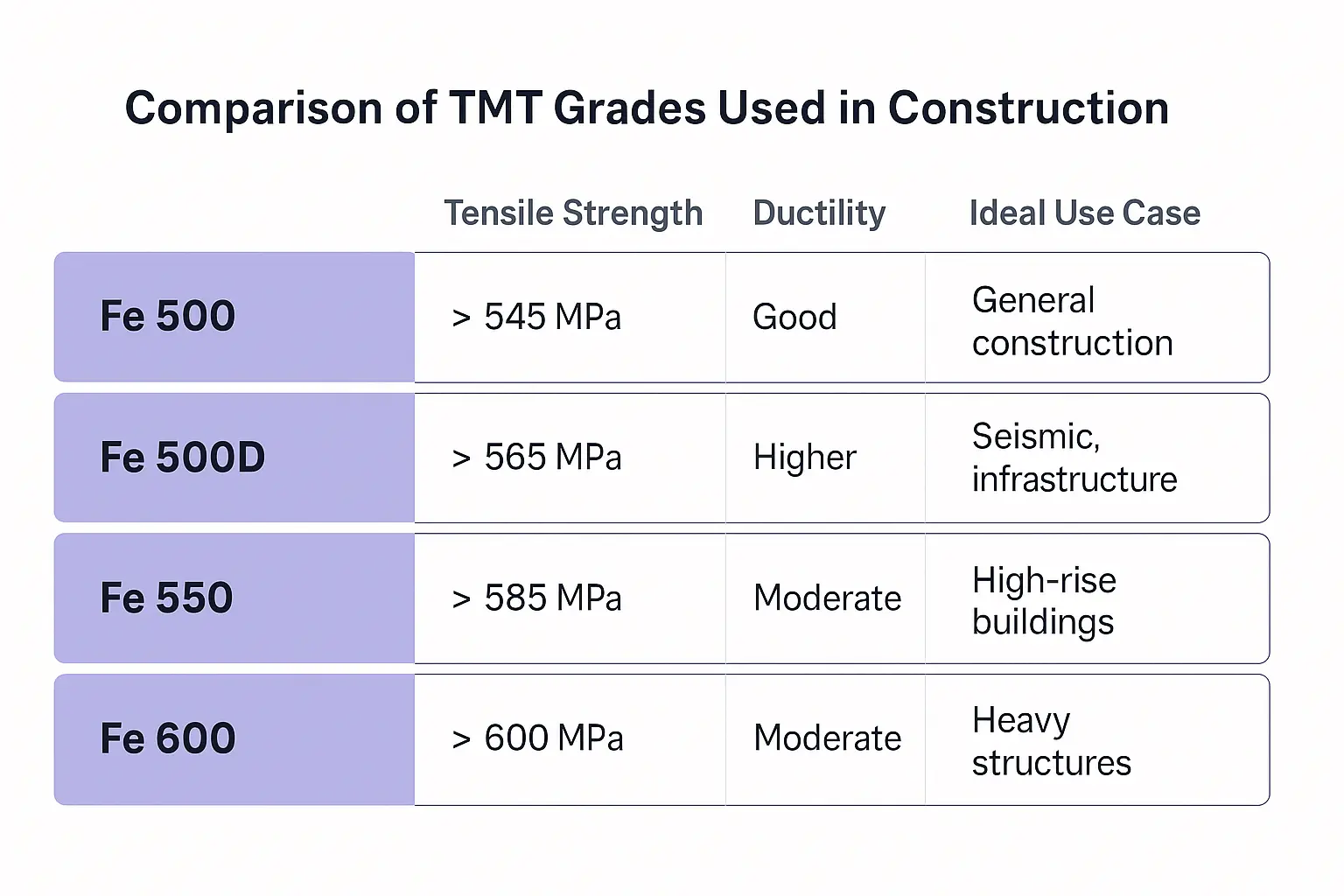
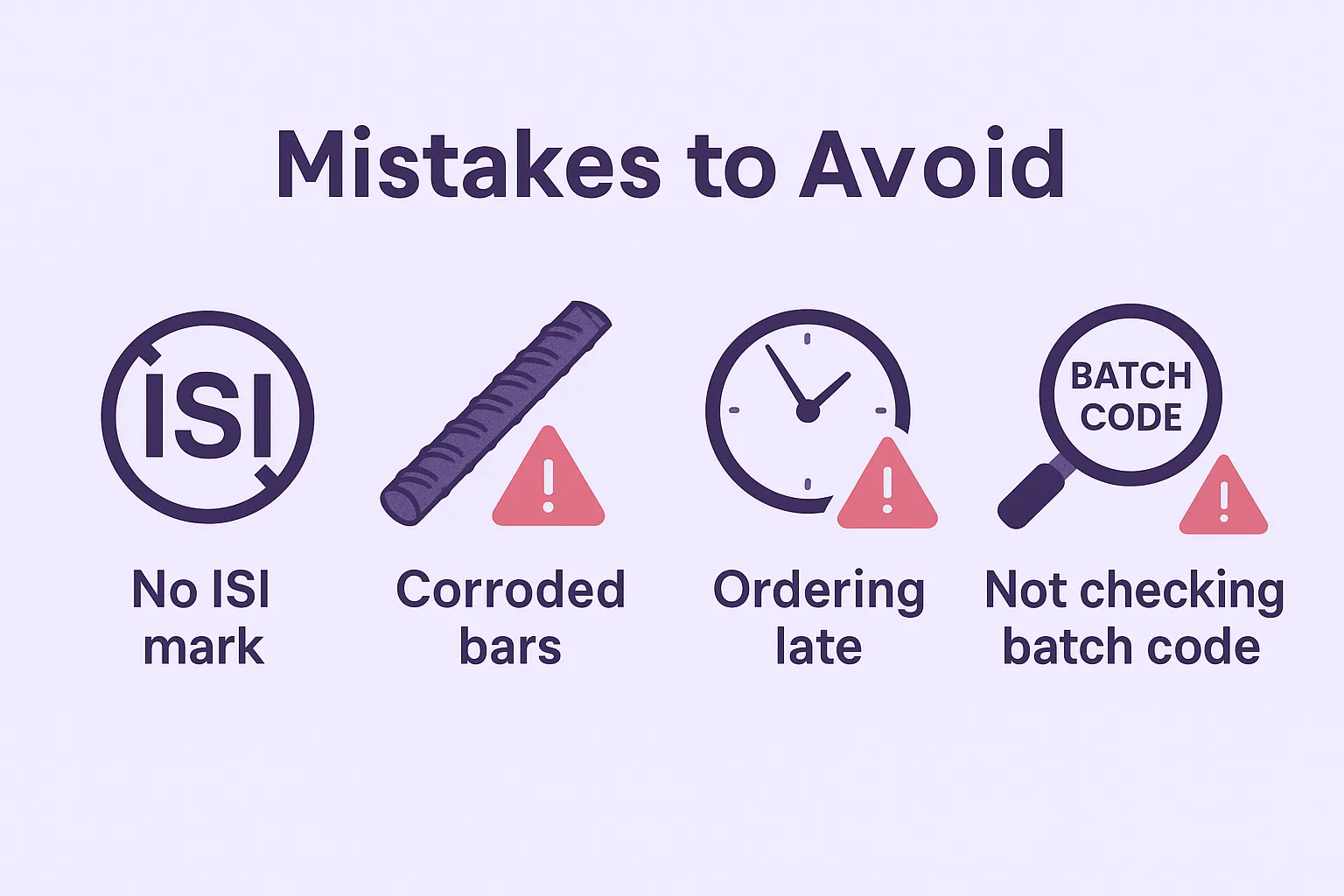
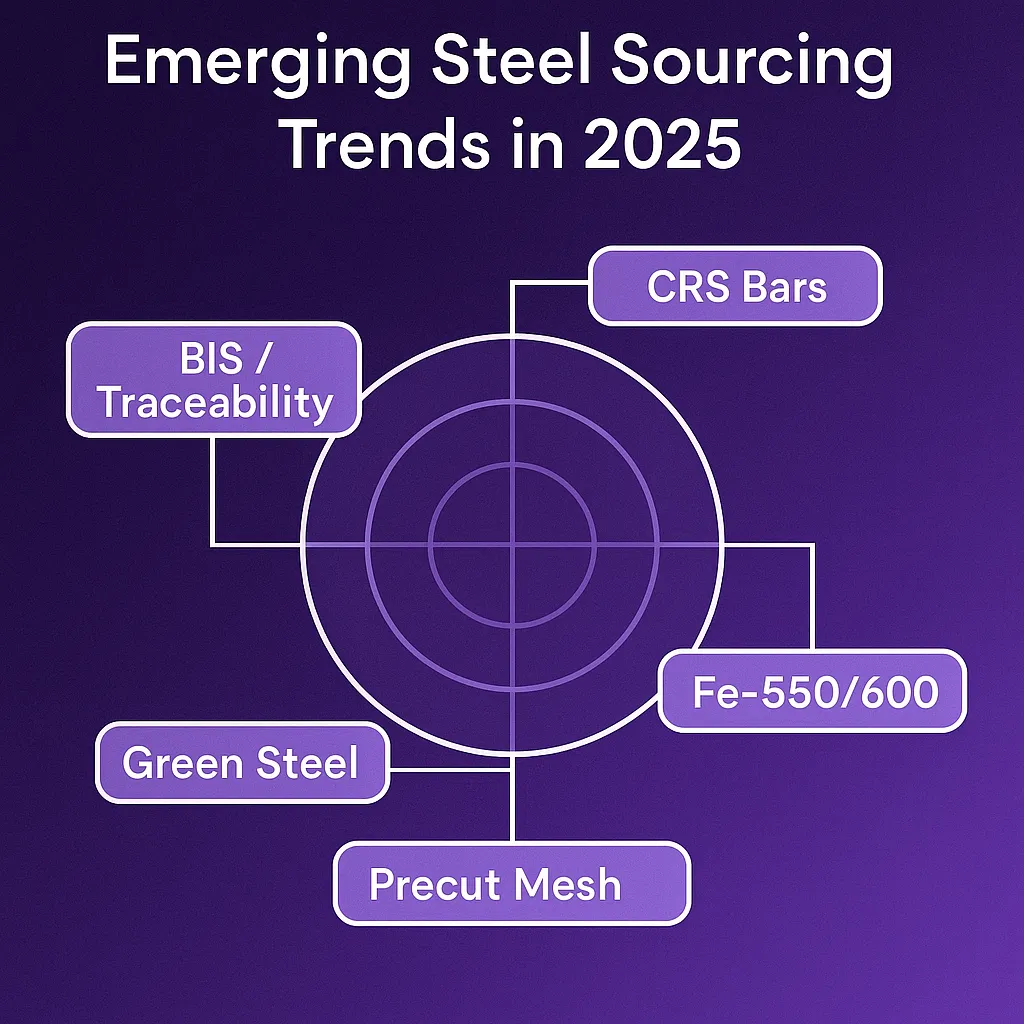
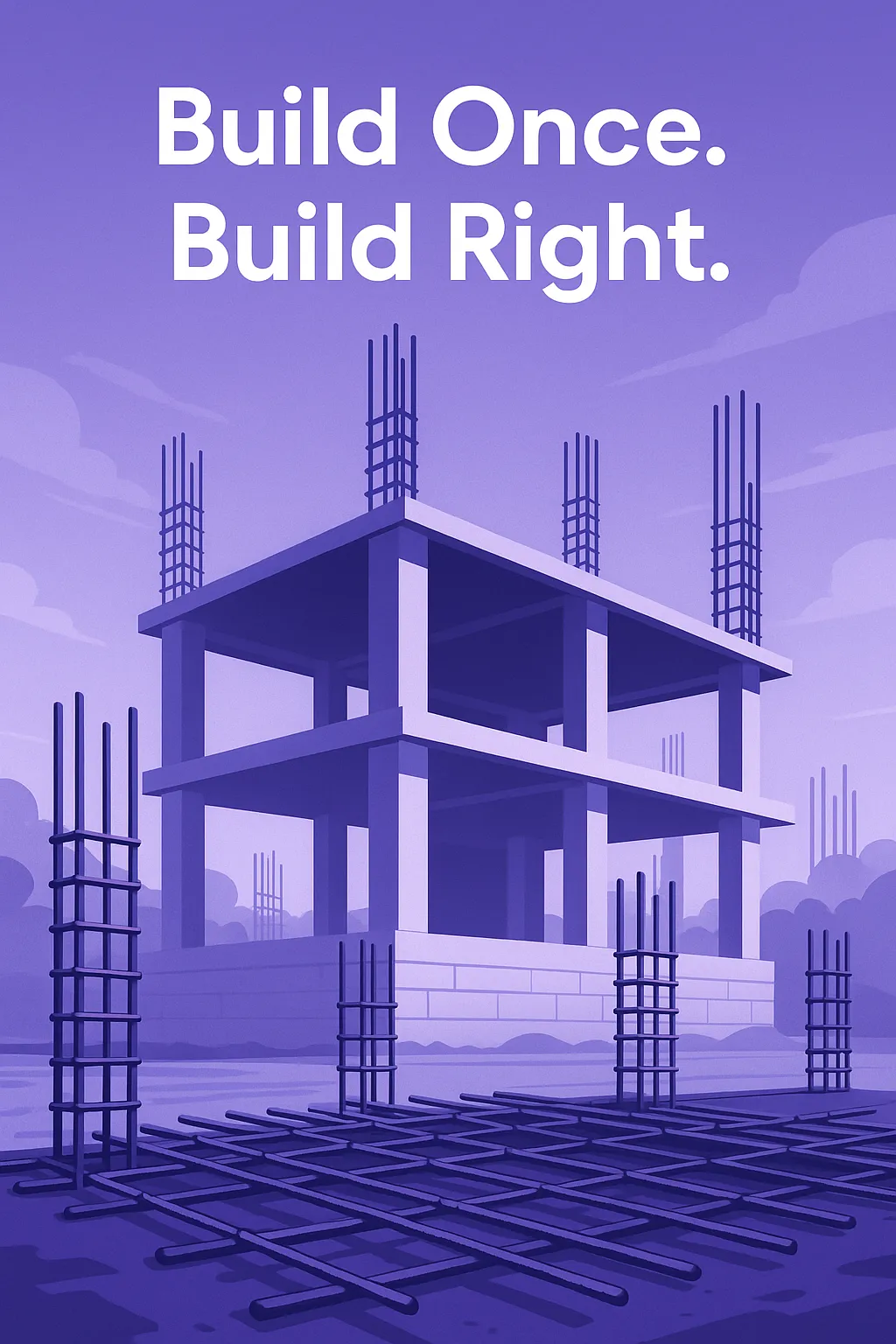

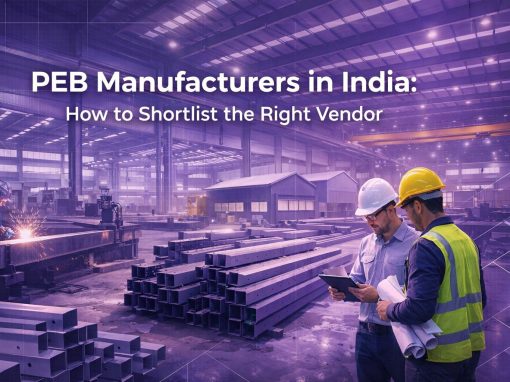
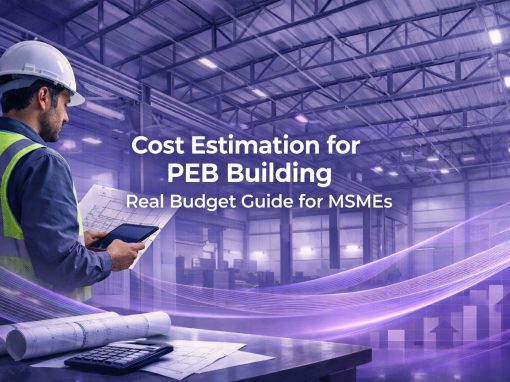

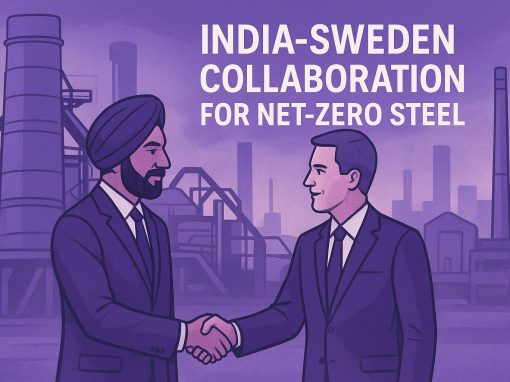
Thanks for covering this – clarifies TMT vs. MS rods perfectly, which is a game-changer for client quotes and discussions. Plus, the pricing info with regional variations is super helpful for budgeting. Definitely bookmarking this for future projects – saves me tons of time researching and keeps my projects on track!
It’s like having a handy reference tool to help you navigate the world of construction materials, whether you’re building a new office complex or renovating your storefront.
Hii sir my metal scrap
+917061442729